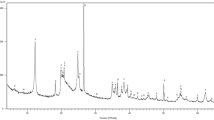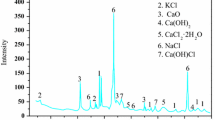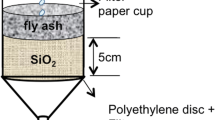Abstract
The leaching of Cr(VI) from lignite fly ash was investigated by means of experimental standards and theoretical simulations. Two lignite fly ash samples with different calcium oxide concentration were examined. Acid extraction of fly ash and batch leaching tests were performed at various liquid (water) to solid (fly ash) ratios (L/S) for the estimation of Cr(VI) leaching rate. The mobility of Cr(VI) in soil and soil’s hydraulic conductivity at different temperatures was also examined. The results indicate that chromium in fly ash occurs mainly in its trivalent form and that Cr(VI) can be leached, but at lower degree. Along with Cr(VI), the strong reducing agent Fe(II) is also leached. A portion of the Cr(VI) is readily leached, while several hours are needed for reaching Cr(VI) equilibrium concentration in leachate. The fly ash hydraulic conductivity is greatly affected by its pozzolanic characteristics, decreasing from around 10 mm/h (2.78 × 10−6 m/s) to values lower than 1 mm/h (2.78 × 10−7 m/s) in few hours. In continuous leaching tests, relatively low Cr(VI) concentrations (< 20 μg/L) were detected, while in batch leaching tests with higher water/fly ash contact time, leachate Cr(VI) concentrations up to 700 μg/L were detected depending on the applied L/S ratio. However, for low L/S (0.5–1) ratios, no leachate was obtained. Theoretical calculations were performed in order to estimate the L/S ratios at real conditions (by taking into account the volume and the surface of an ash disposal, the density of ash, the hydraulic conductivity of ash, rainfall rate, and rainfall duration). It was found that in real conditions, high L/S can be obtained only when various specific conditions are fulfilled. Experiments with soil showed that only a small portion (approximately 4%) of the leached Cr(VI) can pass through a relatively thin (12–15 cm) layer of soil, even at low temperatures. Based on the experimental results and the groundwater and surface water quality data of a studied basin, a low contamination risk due to Cr(VI) leaching from lignite fly ash is assessed.



Similar content being viewed by others
References
Agrawal, G. S., Fimmen, L. R., & Chin, Y. P. (2009). Reduction of Cr(VI) to Cr(III) by Fe(II) in the presence of fulvic acids and in lacustrine pore water. Chemical Geology, 262, 328–335. https://doi.org/10.1016/j.chemgeo.2009.02.001.
Amacher M. C. and Baker D. E., (1982). Redox reactions invol+6 ng chromium, plutonium and manganese in soils., Final Report DOE/DP/04515-1, Pennsylvania State Univ., Institute for Research on Land and Water Resources. https://doi.org/10.2172/5030864.
Balagurumurthy, B., Singh, R., & Bhaskar, T. (2015). Recent advances in thermo-chemical conversion of biomass. In Catalysts for thermochemical conversion of biomass (pp. 109–132).
Burris L. E, Juenger M. C (2016) Milling as a pretreatment method for increasing the reactivity of natural zeolites for use as supplementary cementitious materials. Cement and Concrete Composites 65:163–170. https://doi.org/10.1016/j.cemconcomp.2015.09.008.
Dandautiya, R., Singh, A. P., & Kundu, S. (2018). Impact assessment of fly ash on ground water quality: An experimental study using batch leaching tests. Waste Management and Research, 36, 624–634. https://doi.org/10.1177/0734242X18775484.
Dermatas, D., Vatseris, C., Panagiotakis, I., & Chrysochoou, M. (2012). Potential contribution of Geogenic chromium in groundwater contamination of a Greek heavily industrialized area. Chemical Engineering Transactions, 28, 217–222. https://doi.org/10.3303/CET1228037.
Du, B., Li, J., Fang, W., & Liu, J. (2019). Comparison of long-term stability under natural ageing between cement solidified and chelator-stabilised MSWI fly ash. Environmental Pollution, 250, 68–78. https://doi.org/10.1016/j.envpol.2019.03.124.
Eary, L. E., & Rai, D. (1987). Kinetics of chromium(III) oxidation to chromium(VI) by reaction with manganese dioxide. Environmental Science and Technology, 21, 1187–1193. https://doi.org/10.1021/es00165a005.
Eary, L. E., & Rai, D. (1988). Chromate removal from aqueous wastes by reduction with ferrous Iron. Environmental Science and Technology, 22(8), 972–977. https://doi.org/10.1021/es00173a018.
European Standard. (1999). Water quality-determination of dissolved Li+, Na+, NH4+, K+, Mn+2, Ca+2, Mg+2, Sr+2 and Ba+2 using ion chromatography-method for water and waste water. ISO14911:1998. Brussels: European Committee for Standardization.
European Standard. (2001). Water quality-determination of dissolved fluorides, chlorides, nitrites, orthophophates, bromides, nitrates and sulphates ions by liquid chromatography of ions-part 1: Method for low charge waters. ISO 10304-1. Brussels: European committee for Standardization.
Fendorf, S. E. (1995). Surface reactions of chromium in soils and waters. Geoderma, 67, 55–71. https://doi.org/10.1016/0016-7061(94)00062-F.
Fernandez, A., Munoz, E., Santos, E., Aldaco, R., & Irabien, A. (2019). Environmental performance of alternatives to treat fly ash from a waste to energy plant. Journal of Cleaner Production, 231, 1016–1026. https://doi.org/10.1016/j.jclepro.2019.05.279.
Fytianos, K., Tsaniklidi, B., & Voudrias, E. (1998). Leachability of heavy metals in greek fly ash from coal combustion. Environment International., 24, 477–486. https://doi.org/10.1016/S0160-4120(98)00027-0.
Georgakopoulos, A., Filippidis, A., Kassoli-Fournaraki, A., Iordanidis, A., Fernandez-Turiel, J. L., Liorens, J. F., & Gimeno, D. (2002). Environmentally important elements in fly ashes and their leachates of the power stations of Greece. Energy Sources, 24, 83–91. https://doi.org/10.1080/00908310252712325.
Hausladen, D. M., & Fendorf, S. (2017). Hexavalent chromium generation within naturally structured soils and sediments. Environmental Science and Technology, 51, 2058–2067. https://doi.org/10.1021/acs.est.6b04039.
Hellenic National Meteorological Service, Climatic Data: http://www.hnms.gr/emy/el/climatology/climatology_city?perifereia=West%20Macedonia&poli=Kozani. Accessed September 2019.
Huffman, G. P., Huggins, F. E., Shah, N., & Zhao, J. (1994). Speciation of arsenic and chromium in coal and combustion ash by XAFS spectroscopy. Fuel Processing Technology, 39, 47–62. https://doi.org/10.1016/0378-3820(94)90171-6.
Jacobs, A., & Testa, S. (2004). In J. Guertin, A. J. Jacobs, & P. C. Avakian (Eds.), Overview of chromium (VI) in the environment: background and history from chromium (VI). Handbook (p. 22). CRC Press.
Kazakis, N., Kantiranis, N., Kalaitzidou, K., Kaprara, E., Mitrakas, M., Frei, R., Vargemezis, G., Tsourlos, P., Zouboulis, A., & Filippidis, A. (2017). Origin of hexavalent chromium in groundwater: The example of Sarigkiol Basin, Northern Greece. Science of the Total Environment, 593-594, 552–566. https://doi.org/10.1016/j.scitotenv.2017.03.128.
Kazakis, N., Kantiranis, N., Kalaitzidou, K., Kaprara, E., Mitrakas, M., Frei, R., Vargemezis, G., Vogiatzis, Z. A., & Filippidis, A. (2018). Environmentally available hexavalent chromium in soils and sediments impacted by dispersed fly ash in Sarigkiol basin (Northern Greece). Environmental Pollution, 235, 632–641, ISSN 0269-7491. https://doi.org/10.1016/j.envpol.2017.12.117.
Koralegedara, N. H., Al-Abed, S. R., Arambewela, M. K., & Dionysiou, D. D. (2017). Impact of leaching conditions on constituents release from flue gas desulfurization gypsum (FGDG) and FGDG-soil mixture. Journal of Hazardous Materials, 324, 83–93. https://doi.org/10.1016/j.jhazmat.2016.01.019.
Kumar, A., & Samadder, S. R. (2015). Analysis of the leaching behavior of elements from coal combustion residues for better management. Environmental Monitoring and Assessment, 187, 370. https://doi.org/10.1007/s10661-015-4605-4.
Murthy, V. (2003). Geotechnical engineering principles and practices of soil mechanics and foundation engineering. New York: Marcel Dekker Inc..
Ndung’u, K., Friedrich, S., Gonzalez, A. R., & Flegal, R. A. (2010). Chromium oxidation by manganese (hydr)oxides in a California aquife. Applied Geochemistry, 25, 377–381. https://doi.org/10.1016/j.apgeochem.2009.12.004.
Oze, C., Fendorf, S., Bird, D. K., & Coleman, R. G. (2004). Chromium geochemistry of serpentine soils. International Geology Review, 46, 97–126. https://doi.org/10.2747/0020-6814.46.2.97.
Palmer C D, Puls R.W (1994) Natural attenuation of hexavalent chromium in groundwater and soils, EPA154015–941505, Ground Water Issue.
Papazotos, P., Vasileiou, E., & Perraki, M. (2019). The synergistic role of agricultural activities in groundwater quality in ultramafic environments: The case of the Psachna basin, central Euboea, Greece. Environmental Monitoring and Assessment, 191, 317. https://doi.org/10.1007/s10661-019-7430-3.
Phua, Z., Giannis, A., Dong, Z.-L., Lisak, G., & Ng, J. W. (2019). Characteristics of incineration ash for sustainable treatment and reutilization. Environmental Science and Pollution Research, 26, 16974–16997. https://doi.org/10.1007/s11356-019-05217-8.
Rai, D., Zachara, J. M., Eary, L. E., Girvin, D. C., Moore, D. A., Resch, C. T., Sass, B. M., & Schmidt, R. L. (1986). Geochemical behavior of chromium species, interim report Electric Power Research Institute (EPRI) EA EA–4544. Palo Alto, CA: EPRI.
Rai, D., Sass, B. M., & Moore, D. A. (1987). Chromium(lll) Hydrolysis Constants and Volubility of Chromium(lll) Hydroxide Inorg., 26(3), 345–249. https://doi.org/10.1021/ic00250a002.
Rai, D., Eary, L. E., & Zachara, J. M. (1989). Environmental chemistry of chromium. The Science of the Total Environment, 86, 15–23. https://doi.org/10.1016/0048-9697(89)90189-7.
Rice E. W, Baird R. B, Eaton A. D, Clesceri L. S, (2012) Standard methods for the examination of water and wastewater, 22nd American Public Health Association-American Water Works Association-Water Environment Federation.
Saha, R., Nandi, R., & Saha, B. (2011). Review: Sources and toxicity of hexavalent chromium. Journal of Coordination Chemistry, 64(10), 1782–1806. https://doi.org/10.1080/00958972.2011.583646.
Sass, B. M., & Rai, D. (1987). Solubility of amorphous chromium( +3 )-iron( +3 ) hydroxide solid solutions. Inorganic Chemistry, 26, 2228–2232. https://doi.org/10.1021/ic00261a013.
Silva, E. B., Li, S., Oliveira, L. M., Gress, J., Dong, X., Wilkie, A. C., Townsend, T., & Ma, L. Q. (2018). Metal leachability from coal combustion residuals under different pHs and liquid/solid ratios. Journal of Hazardous Materials, 341, 66–74. https://doi.org/10.1016/j.jhazmat.2017.07.010.
Stamos, A., Samiotis, G., Pekridis, G., Tsioptsias, C., & Amanatidou, E. (2019). Natural presence of hexavalent chromium in spring waters of South-West Mountain Vermion, Greece. CEST 2019. In 16th international conference on environmental science and technology. Greece: Rhodes.
Swietlik, R., Trojanowska, M., Lozynska, M., & Molik, A. (2014). Impact of solid fuel combustion technology on valence speciation of chromium in fly ash. Fuel, 137, 306–312. https://doi.org/10.1016/j.fuel.2014.08.010.
Teixeira, E. R., Camoes, A., Branco, F. G., Aguiar, J. B., & Fangueiro, R. (2019). Recycling of biomass and coal fly ash as cement replacement material and its effect on hydration and carbonation of concrete. Waste Management, 94, 39–48. https://doi.org/10.1016/j.wasman.2019.05.044.
Tian, Q., Guo, B., Nakama, S., & Sasaki, K. (2018). Distributions and leaching behaviors of toxic elements in fly ash. ACS Omega, 3, 13055–13064. https://doi.org/10.1021/acsomega.8b02096.
USEPA(2012a) Method 1313, liquid-solid partitioning as a function of extract pH using a parallel batch extraction procedure.
USEPA (2012b) Method 1316, liquid-solid partitioning as a function of liquid-to-solid ratio in solid materials using a parallel batch procedure.
Uzal, B., Turanli, L., Yucel, H., Goncuoglou, M. C., & Culfaz, A. (2010). Pozzolanic activity of clinoptilolite: A comparative study with silica fume, fly ash and a non-zeolitic natural pozzolan. Cement and Concrete Research, 40, 398–404. https://doi.org/10.1016/j.cemconres.2009.10.016.
Vasileiou, E., Papazotos, P., & Dimitrakopoulos, D. (2019). Expounding the origin of chromium in groundwater of the Sarigkiol basin, Western Macedonia, Greece: A cohesive statistical approach and hydrochemical study. Environmental Monitoring and Assessment, 191, 509. https://doi.org/10.1007/s10661-019-7655-1.
Voutsis, N., Kelepertzis, E., Tziritis, E., & Kelepertsis, A. (2015). Assessing the hydrogeochemistry of groundwaters in ophiolite areas of Euboea Island, Greece, using multivariate statistical methods. Journal of Geochemical Exploration, 159, 79–92. https://doi.org/10.1016/j.gexplo.2015.08.007.
Wang, J. (2018). Statistical study on distribution of multiple dissolved elements and a water quality assessment around a simulated stackable fly ash. Ecotoxicology and Environmental Safety, 159, 46–55. https://doi.org/10.1016/j.ecoenv.2018.04.057.
Yilmaz, H. (2015). Characterization and comparison of leaching behaviors of fly ash samples from three different power plants in Turkey. Fuel Processing Technology, 137, 240–249. https://doi.org/10.1016/j.fuproc.2015.04.011.
Zhang, J., Yin, H., Wang, H., Xu, L., Samuel, B., Chang, J., Liu, F., & Chen, H. (2019). Molecular structure-reactivity correlations of humic acid and humin fractions from a typical black soil for hexavalent chromium reduction. Science of the Total Environment, 651, 2975–2984. https://doi.org/10.1016/j.scitotenv.2018.10.165.
Zhong, L., Yang, J., Liu, L., & Xing, B. (2015). Oxidation of Cr+3 on birnessite surfaces: The effect of goethite and kaolinite. Journal of Environmental Sciences, 37, 8–14.
Author information
Authors and Affiliations
Corresponding author
Additional information
Publisher’s Note
Springer Nature remains neutral with regard to jurisdictional claims in published maps and institutional affiliations.
Rights and permissions
About this article
Cite this article
Tsioptsias, C., Samiotis, G., Lefteri, L. et al. Cr(VI) Leached from Lignite Fly Ash—Assessment of Groundwater Contamination Risk. Water Air Soil Pollut 231, 373 (2020). https://doi.org/10.1007/s11270-020-04750-4
Received:
Accepted:
Published:
DOI: https://doi.org/10.1007/s11270-020-04750-4




